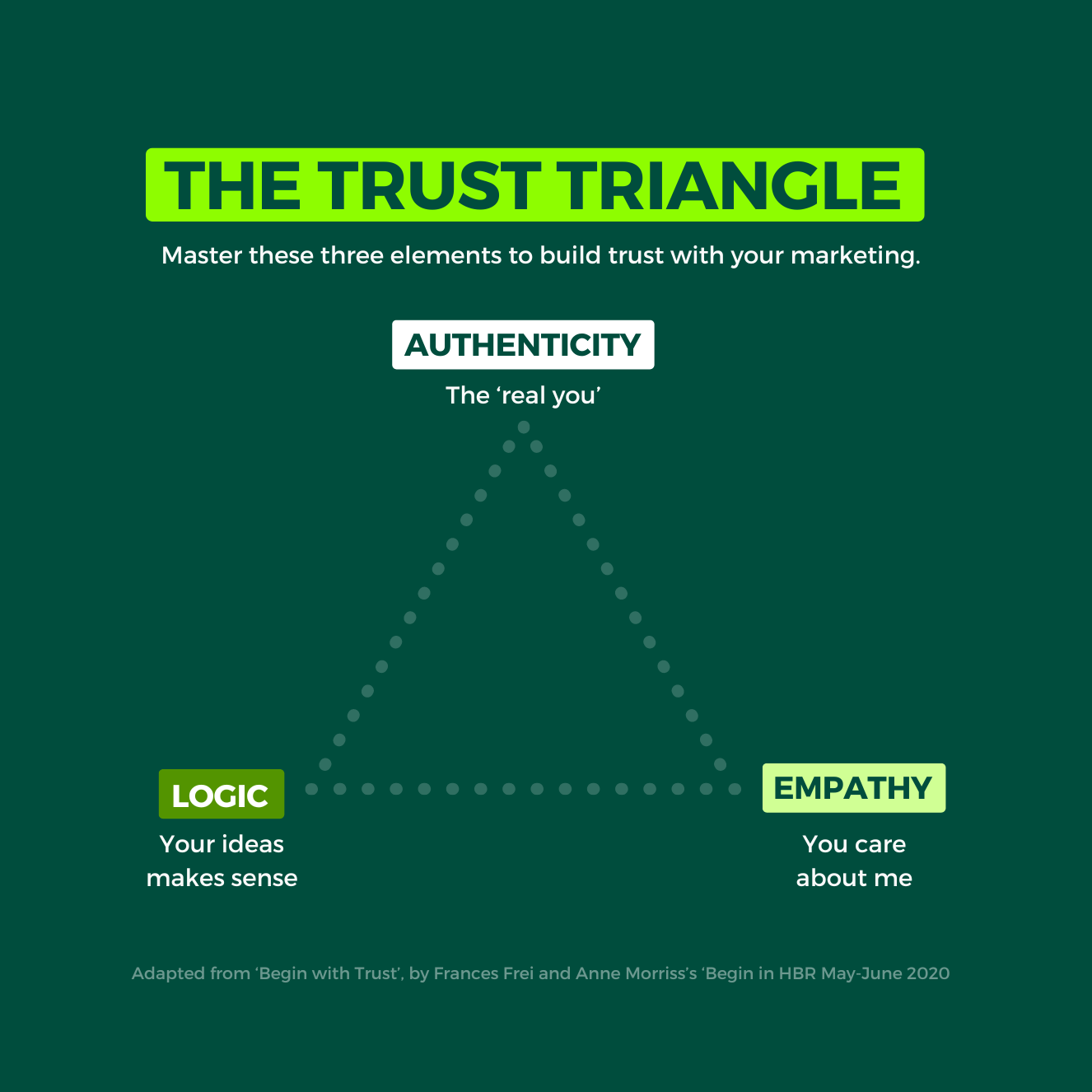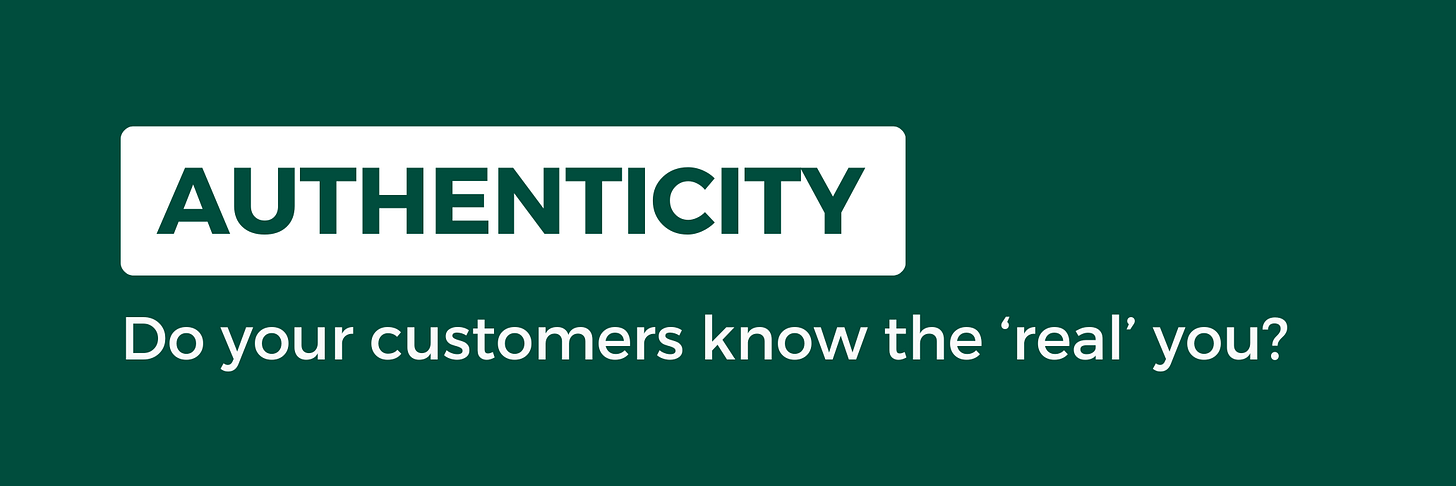Three keys to building trust in climate tech
Has your brand mastered the three points of the trust triangle?
Hello friends,
Climate tech has a big trust problem.
Carbon markets is in particular trouble — and if you work in the VCM, you know this firsthand.
Trust matters because it forms the foundation for all that comes after. Without trust, efforts to educate are futile (think of the government attempts to educate around masks and vaccines during the pandemic).
Doubt is powerful, and once it takes hold it’s incredibly difficult to escape its grasp. For many climate tech players, but especially those in carbon markets, doubt has a stronghold over would-be buyers.
We need to rewrite the story. But how do we rebuild trust in the midst of such fear?
Enter the trust triangle.
Frances Frei and Anne Morriss believe that trust hinges on three pillars: authenticity, empathy, and logic.
Authenticity: ‘I experience the real you.’
Empathy: ‘I believe you care about me and my success.’
Logic: ‘I know you can do it; your reasoning and judgment are sound.’
For climate tech and carbon market companies, authenticity is the result of branding that feels relatable and human. Empathy is how you connect with customers and demonstrate you understand their desires and pain points. Logic is your value proposition: the reason you exist, and the reason you can help your buyers.
If authenticity is about you, and empathy is about them, then logic is the unbiased, common sense, irrefutable third party. This is why we see the triangle as more of a bridge. Your brand (authenticity) is on one side, your customer (empathy) is on the other, and logic helps to bridge the gap.
So what can climate and carbon companies do to strengthen trust?
Authenticity
We put a lot of focus on authenticity in the report. Overall it’s something brands are getting better at, but many aren’t taking it seriously enough.
When someone first interacts with your brand, you’re a stranger to them — an entity to keep at arm’s length. Authenticity is how you begin to bridge that gap; it’s the difference between your customers viewing your exchange as purely transactional versus building an association that feels akin to a friendship.
Strategies to build authenticity
To build authenticity, companies need to show their human side. This is an important consideration as you develop your brand’s voice, which, when done well, can implicitly communicate your worldview, attract right-fit customers, and repel the others.
But beyond your ‘company’ voice, we encourage you to lean into your human side by showcasing the actual humans behind the brand. These people will always be more captivating and persuasive than a logo with a quirky tone of voice. Encourage team members to speak in the first person; there’s no need to pretend they and the company are the same. Turn them into mini-brands. Show photos and talk about their background. Encourage them to create their own LinkedIn content, with the help of a ghostwriter or editor if they feel they need it.
Why we avoid too much ‘polishing’
Sometimes we’re asked to ‘polish up’ something a CEO or SME has written. It may be counterintuitive, but we try to change as little as possible. We know that audiences can tell the difference between something written by one person and something edited by 10+ people on the marketing team. (And guess which they prefer?)
Empathy
We see a surprising lack of empathy in climate tech. Marketers must strike the right balance between simple and nuanced — which can only happen when you’ve gained a thorough understanding of your customers’ prior knowledge or lack thereof.
Strategies to build empathy
Understanding your audience is the foundation for building empathy. Voice-of-customer exercises that allow you to reflect your customers’ thoughts and feelings back to them are particularly powerful.
Map your ideal customers against the three stages of the corporate climate maturity journey. Understand their daily challenges by following publications for sustainability professionals, sitting in on sales calls, and interviewing customers. Then, work those stories and precise language back into your communications and content. In all your customer-facing communications, find ways to acknowledge how hard it is to be in their shoes before you launch into education or sales pitch mode. Case studies crafted through a narrative lens can also help to universalize pain points.
Logic
Our favorite part! The climate tech industry began out of logic. Innovations like clean power and carbon credits are highly logical solutions to difficult problems. But we believe many brands lack simple, logical premises in their communications and content.
That’s not to say what they’re putting out is illogical — far from it. But too much of the content we see dives deep into nuanced, technical issues, and fails to come back to tried and true common sense principles.
A few examples —
Many of the thought ‘influencers’ we follow on social media (mostly LinkedIn and Twitter/X) create their content around 1-3 very simple, common sense principles. They come back to these core principles so often that, after following them for a while, you could easily sum up their philosophies.
Here are some of our favorite influencers and their common-sense philosophies:
Justin Welsh — solopreneurship = freedom
Ramit Sethi — money is an enabler
Shane Parrish — better thinking leads to a better life and career
Lubomila Jordanova — climate change is everyone’s business
Matt Gray — systems are the key to growth
Strategies to build logic
We recommend brands identify their one or handful of common sense principles and ensure every piece of content links back to them. This doesn’t mean you can’t create nuanced long-form content, but the thesis (a common sense principle) should always be made clear.
The takeaway?
For climate and carbon companies, trust is as precious as it is scarce. The trust triangle offers a pathway for rewriting climate tech stories in the midst of fear.
And that means…
Climate tech marketers can use the three pillars of the trust triangle to bridge the gap between skepticism and confidence, and between brands and their audiences.
The challenge ahead:
It is only through mastering these pillars — authenticity (the real you), empathy (you care about your customer), and logic (your unbiased, common-sense philosophies) — that brands can begin the critical work of freeing their would-be customers from doubt’s grip.
Educational resources
A great primer for improving critical thinking skills. To ensure your brand communications are founded on logical principles, start with improving your own thinking habits.
A must-read for marketers and founders alike. The key theme of this book is ‘pick a message and stick to it,’ which turns out to be highly relevant for building both authenticity and logic.








